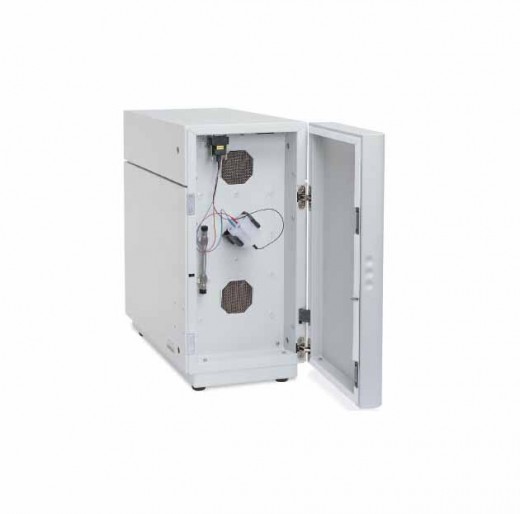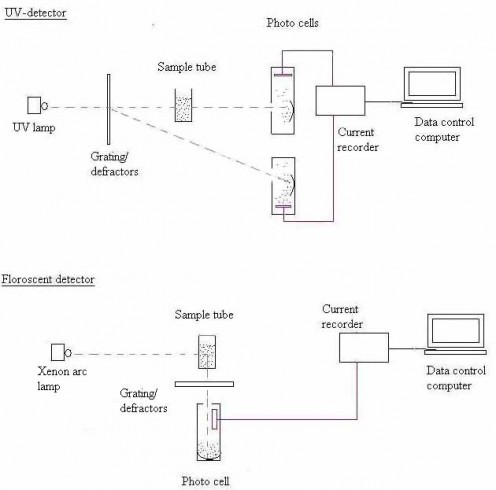HPLC detector types: Principle in their working
HPLC detectors constitute an important accessories of HPLC instrument.
This part of HPLC helps in detection and identification of compounds in the sample injected.
These detectors are designed to have certain properties like
♦ Being inert (non-reactive) to the samples injected and the mobile phases passing through.
♦ Preferably non-destructive to the sample.
♦ Produce quick and quantitative response.
♦ Produce uniform, reliable and reproducible detection and analytic data.
♦ Compatible for all types of compounds under testing.
♦ Should have good sensitivity .i.e able to detect compounds at very low concentration in the ranges below micro-grams, nano-grams etc. as the sample quantity may be lower in many cases.
All types of HPLC detectors comply with most of the above properties.

UV detectors: These detector systems work on the spectroscopy principle. The sample detection depends on the absorption of UV rays energy by the sample. The equipment comprises of accessories in order as a UV source, grating (for light diffraction), sample passing through a tubing exposed to rays, photocell, charge conductor, etc.
When the UV rays emitted by lamp pass through gratings, rays split into different wavelengths. One specific wavelength rays are passed through the sample. Some amount of light is absorbed by the sample and the unabsorbed rays which fall on the photocell.
These rays on collision on photocell produce electrons whose current is recorded. This is indicative of the nature and quantity of the sample. This UV wavelength range of absorption is specific for the sample .
These are the HPLC detectors used in general, unless there is a requirement for analysis of special compounds.
They are capable to detect a very wide range of compounds.
The sensitivity ranges until the microgram quantity of estimation.
PDA detectors: These are detectors that follow principle similar to UV detectors but the range of detection extends from UV, visible and to some extent to IR region. Thus the advantages are higher sensitivity and measures the entire absorption range i.e it gives the scan of the entire spectrum.
More on HPLC
HPLC Detector types
Based on the method or principle used in detection the detectors available are UV detectors, Fluorescent detectors, Electrochemical detectors, and Photo diode-array detectors (PDA).
Refractive index detectors; These are detectors that measure the change of the refractive index of the eluant from the column with respect to the pure mobile phase. They have several disadvantages like lack of high sensitivity, non-suitability for gradient elution, and also require strict temperature control ±0.001oC to operate at their highest sensitivity.
Principle in UV Floroscent detectors

HPLC Fluorescence detector
In this detector, the fluorescence rays emitted by the sample after absorbing incident light is measured as a function of quality and quantity of the sample.
The equipment comprises of accessories in order as light source, sample passing through a tubing exposed to rays, grating (for light diffraction), photocell, charge conductor, etc.
The xenon arc lamp is used to produce light for the excitation of sample molecules. These light rays excite the sample molecules. These excited molecules emit fluorescence, which passes through gratings. These gratings pass the fluorescence at specific wavelength to a photocell which is recorded.
The detector is suitable for compounds which can produce fluorescence.
Some compounds are chemically altered to produce fluorescence by chemical derivatization to estimate by this detector.
These detectors have high precision and sensitivity (with less noise in data).
Compounds are measurable until nanogram quantities.
Related books
HPLC Electrochemical detector
This detector is especially suitable to estimate oxidizable & reducible compounds.
The principle is that when the compound is either oxidized or reduced, the chemical reaction produces electron flow. This flow is measured as the current which is the function of type and quantity of compound.
The system has electrodes like a working electrode where oxidation or reduction takes place and reference electrode which acts to subtract conductivity of the mobile phase to that of a sample.
This electrode is suitable for compounds that can't be assayed by UV detector especially due to their similarities in light absorption properties ex: monoamines.
This detector has super sensitivity which ranges till picograms measurement. So a very minute quantity of compounds present in the samples can be measured.
This electrochemical detector produces severe noise or fluctuations in peaks. So it is tedious to work with when compared to other detectors.
As such all types of HPLC detectors are used based on the requirement of labs.
Precautions in selection and use of detector
1. Always select a suitable detector that is well tested and prescribed after proper validation of the said compound by HPLC analysis. This can be known by standard books of reference like Pharmacopoeias of U.S. India, British, etc.
The detectors should be checked for their response to commands by the operating software for any external connection problems.
2. The calibration of detectors is to be performed for any new experiment to achieve stability in data and responses.
3. The mobile phase used should be of HPLC grade and free from air bubbles, this may give errors in data.
4. The room temperature is preferably constant & low.
The technology of detectors is evolving further by a combination of other analytical methods.
For any queries use the comments section to get solutions.
Thanks...............






